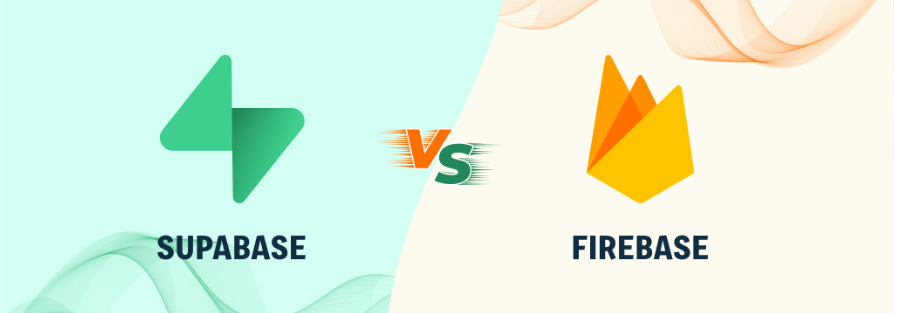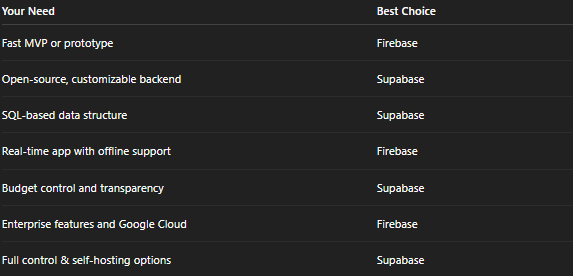Supabase or Firebase: Which Backend Fits Your Needs in 2025?
Compare features, performance, pricing, and use cases to find the right backend solution for your next web or mobile project.
When you're building a web or mobile app in 2025, one of the most important decisions you'll face is choosing the right backend. Your backend is like the engine of a car—it powers everything behind the scenes. Two of the most popular backend-as-a-service (BaaS) platforms today are Firebase by Google and Supabase, an open-source alternative that’s gaining attention fast.
Whether you’re a solo developer or working with a Full-Stack Development Company, picking the right backend can make or break your project. And if you’ve been exploring backend options lately, chances are you’ve come across Supabase and Firebase — two powerful platforms that developers are using to build everything from hobby apps to full-blown businesses.
So, which one is right for you in 2025? This blog will help you understand the differences between Supabase and Firebase in simple, non-technical language. Whether you’re a startup founder, solo developer, or business owner planning your next big product, we’ll walk you through what each platform offers, their pros and cons, and which one is best for your specific needs.
What Are Firebase and Supabase?
Firebase
Firebase is a Backend-as-a-Service (BaaS) platform developed by Google. It helps developers build apps without managing servers. Firebase provides services like real-time databases, authentication, cloud storage, hosting, and more—all ready to use with a few lines of code.
Supabase
Supabase is an open-source alternative to Firebase that offers a similar BaaS experience. It’s built on top of PostgreSQL (a popular open-source database) and provides tools like authentication, APIs, storage, and a real-time database. It’s a newer player but is growing quickly in popularity among developers.
What Are Firebase and Supabase?
Firebase
Firebase is a Backend-as-a-Service (BaaS) platform developed by Google. It helps developers build apps without managing servers. Firebase provides services like real-time databases, authentication, cloud storage, hosting, and more—all ready to use with a few lines of code.
Supabase
Supabase is an open-source alternative to Firebase that offers a similar BaaS experience. It’s built on top of PostgreSQL (a popular open-source database) and provides tools like authentication, APIs, storage, and a real-time database. It’s a newer player but is growing quickly in popularity among developers.
Core Features Comparison (2025)
Let’s look at the key features both platforms offer in 2025 and how they compare.
Firebase in 2025: Pros and Cons
✅ Pros
Backed by Google: Firebase has deep integration with Google Cloud services, making it scalable and reliable.
Real-Time Sync: It allows real-time updates between users and apps, perfect for chat apps or multiplayer games.
Powerful Analytics: Firebase integrates well with Google Analytics and Crashlytics for tracking app usage and crashes.
Easy to Start: The setup process is fast and beginner-friendly, with lots of documentation.
❌ Cons
NoSQL Structure: Firestore and Realtime Database are NoSQL, which can be hard to work with if you’re used to SQL.
Closed Source: Firebase is proprietary, meaning you can't host it yourself or tweak the internals.
Vendor Lock-in: Moving away from Firebase can be difficult once you scale.
Can Get Expensive: Once your app grows, Firebase pricing can ramp up fast, especially if you have many reads and writes.
Supabase in 2025: Pros and Cons
✅ Pros
SQL-Based: Supabase uses PostgreSQL, which is familiar to most developers and easier for complex data relationships.
Open Source: Supabase is completely open-source. You can even self-host it if needed.
More Control: You have more freedom to customize, add extensions, and manage the database.
Transparent Pricing: Supabase offers a generous free tier and simple pricing models.
❌ Cons
Still Evolving: Supabase is newer than Firebase and may lack some advanced features or integrations.
Smaller Ecosystem: Firebase has a bigger community and more third-party tools.
Learning Curve: While it’s easier for SQL users, beginners with no database experience might need time to adjust.
Use Case Scenarios: Which One Is Better?
1. If You’re Building a Real-Time Chat App
Choose Firebase.
Firebase Realtime Database and Firestore are excellent for syncing chat messages instantly. It also supports offline access, which is a big plus.
2. If You Want Full Control Over the Database
Choose Supabase.
With SQL and open-source flexibility, Supabase gives you more customization power. You can add extensions, write complex queries, and even migrate databases easily.
3. If You’re Creating an MVP (Minimum Viable Product)
Either can work.
Firebase is faster to set up and easier for quick projects. Supabase offers a great free tier and is better for future-proofing if you plan to scale and want control.
4. If You Care About Cost and Transparency
Choose Supabase.
Firebase costs can become hard to predict, especially with lots of database reads. Supabase’s pricing is straightforward and more budget-friendly for growing teams.
5. If You Want a Scalable Production App with Google Services
Choose Firebase.
Its integration with Google Cloud, robust infrastructure, and reliability make it ideal for production-level apps that need to scale globally.
Developer Experience in 2025
Firebase
Offers excellent documentation and SDKs for web, Android, iOS, Flutter, Unity, and more.
Strong support for machine learning via ML Kit.
Google integration makes login/authentication easier.
Supabase
Active and growing developer community.
Built-in APIs and Swagger support make testing easier.
Includes dashboard and SQL editor for easy control of your backend.
Security & Compliance
Firebase supports GDPR, HIPAA (with GCP agreement), and enterprise-grade compliance features.
Supabase, while not as enterprise-focused, is improving compliance and allows full control if you self-host your stack.
Offline Support
Firebase excels in offline capabilities, especially for mobile devices.
Supabase has been working on offline syncing features, but it’s not yet as mature as Firebase in this area.
Future Trends in 2025
Firebase
Likely to continue integrating deeper with Google Cloud AI and BigQuery.
Focused on enterprise and scalability.
Better tools for building web and mobile games.
Supabase
Growing fast in open-source and developer-first tools.
Will likely add more AI capabilities via integrations with open-source models.
A popular choice among startups, open-source apps, and SaaS tools.
Final Verdict: Which One Should You Choose?
Here’s a quick summary to help you decide:
If you're still unsure, try both! Start with their free tiers, build a small version of your app on each, and see which one feels better for your workflow.
Conclusion
Choosing the right backend isn’t just a technical decision—it’s a strategic one. Firebase and Supabase are powerful tools, but they shine in different areas. Think about your current needs, your future goals, and the kind of developer experience you want.
If you’re working with a team or hiring experts, many companies that offer Software Development Services can help you evaluate both platforms based on your app’s specific needs. They can guide you through setup, performance tuning, and long-term scalability so you can focus on building a great user experience.
In 2025, the backend you choose could be the foundation that helps your app scale, attract users, and succeed. So take your time, explore both platforms, and pick the one that truly fits your needs.




